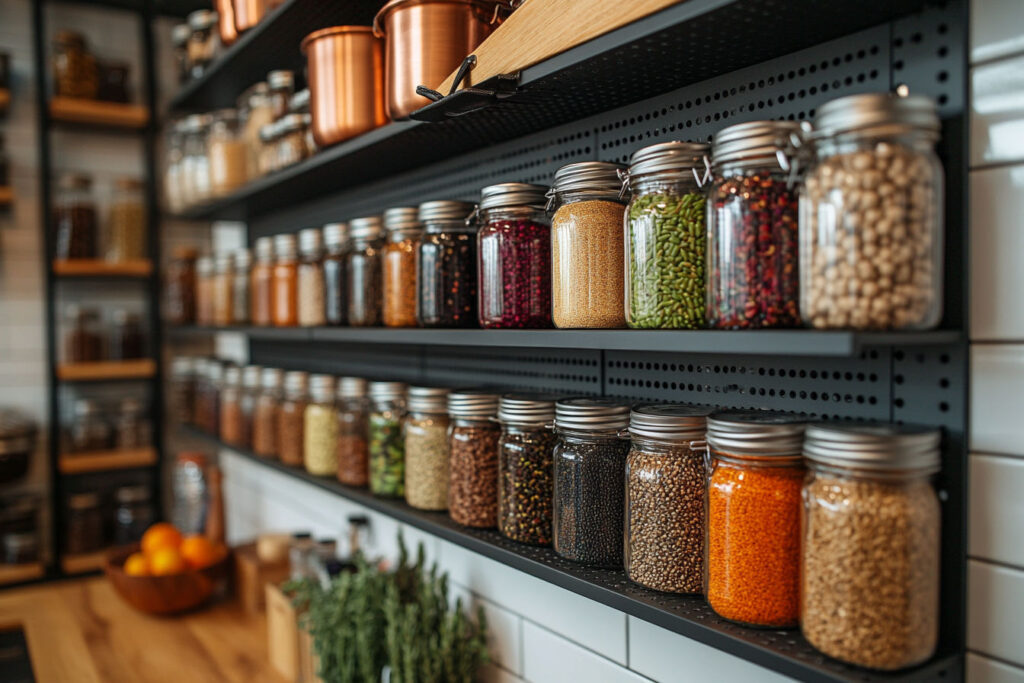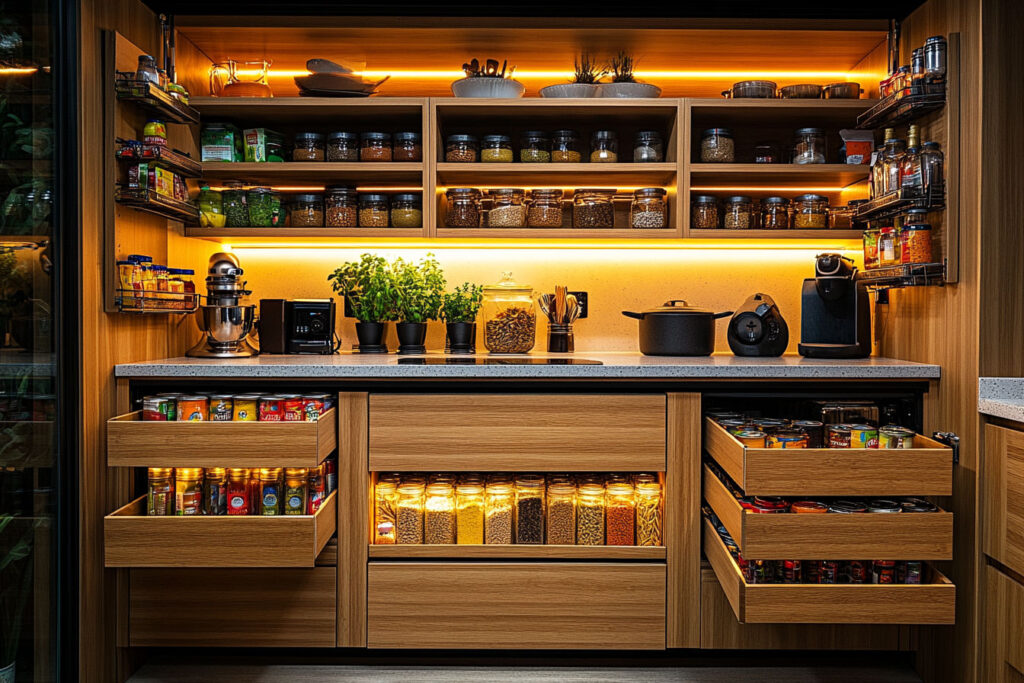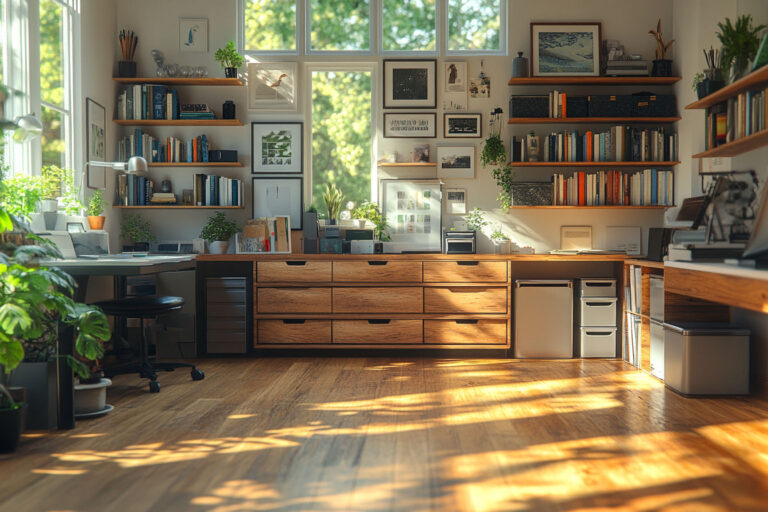This post may contain affiliate links. If you make a purchase through these links, we may earn a commission at no additional cost to you.
Small kitchens define modern urban living, where compact homes and tiny spaces demand smart solutions. Limited square footage doesn’t just challenge cooking—it can sap the joy from a room meant for creativity and connection. Luckily, fresh hacks turn tight quarters into efficient, stylish hubs.
In homes under 1,500 square feet—a common size for city apartments and starter houses—kitchens average just 103 square feet, barely 7% of the total space. That tight footprint doesn’t just challenge cooking—it can sap the joy from a room meant for creativity and connection. Yet, constraints breed brilliance. Fresh hacks turn cramped quarters into efficient, stylish hubs, proving small doesn’t mean stuck. Today’s kitchens juggle meal prep, socializing, and even work-from-home moments, all while battling clutter in a fraction of the home’s layout.
Maximizing Your Small Kitchen: Top Space-Saving Hacks Unveiled
This article unveils top strategies to maximize your small kitchen, spotlighting trends like vertical storage, multi-functional designs, and cutting-edge tech. Whether you rent or own, these ideas flex to fit your lifestyle, proving small spaces hold big potential. From clever shelving to decluttering tricks, each tip prioritizes function without sacrificing charm. Let’s dive into transforming your small kitchen into a powerhouse of efficiency and personality.
Leverage Vertical Space with Smart Shelving

In a small kitchen, every inch counts, and walls and ceilings morph into prime real estate. Leveraging vertical space with smart shelving doesn’t just free up counters and cabinets—it carves out room for chopping, mixing, and stashing appliances. This hack flips the script on cramped layouts, turning unused height into a storage goldmine. Here’s how to make it work, step by step.
Wall-Mounted Racks: Your Go-To Fix
Start with wall-mounted racks—they’re the MVPs of vertical storage. Install them above the sink or stove to hold spices, utensils, or even lightweight pots. A sturdy rack over the sink keeps dish soap and sponges handy, while one near the stove corrals oils and ladles. Pick stainless steel for durability or painted wood for a pop of color.
Pro tip: Measure twice—ensure clearance for your tallest stockpot to avoid a clanging disaster.
Pegboards: Customize Like a Pro
Pegboards bring a customizable twist that adapts to your chaos. Screw one to a blank wall, then hang hooks, baskets, or mini shelves to store cutting boards, colanders, or even a drying rack. Paint it to match your vibe—matte black for sleekness, bright teal for fun. Rearrange as life shifts: swap a basket for a hook when you ditch bulk pasta for a new skillet. It’s all about keeping essentials at arm’s reach without hogging counter space.
Ceiling Racks: Bold and Brilliant
For the fearless, ceiling-mounted racks steal the show. Suspend cookware overhead—think cast-iron pans or copper kettles—and blend industrial chic with hardcore practicality. Anchor them securely into ceiling joists; a wobbly rack spells trouble. This setup shines in kitchens with high ceilings but works anywhere with solid support.
Bonus: It doubles as decor, showing off your gear while freeing cabinet space for bulk buys like rice or canned goods.
Open Shelves: Style Meets Storage
Open shelves nail the balance of function and flair. Mount them along a bare wall to stack dishes, jars, or even cookbooks, turning necessities into eye candy. Opt for floating designs in bamboo or metal—lightweight yet tough—and space them 12–15 inches apart for easy access. Add personality with labeled glass jars of grains or a row of mismatched mugs.
Go modular: swap a shelf out or add another when your collection grows.
Why They Work
Big time flexibility. Lightweight, adjustable designs—racks, pegboards, shelves—let you tweak storage as needs evolve, whether you’re a ramen minimalist or a gadget hoarder. Installation’s a breeze with basic tools (drill, level, screws), and costs stay low—think $20 for a pegboard or $50 for a ceiling rack. The payoff? Clear counters, organized gear, and a kitchen that feels bigger than its footprint. Small spaces don’t just survive—they dominate when you think up, not out.
Invest in Multi-Functional Furniture
Multi-functional furniture transforms a small kitchen into a versatile powerhouse, bending space to your will. It’s not just about fitting in—it’s about thriving, whether you’re sizzling stir-fry, hosting friends, or sipping coffee. This hack blends flexibility with function, squeezing every inch for all it’s worth. Here’s how to roll it out, piece by piece.
Foldable Tables: Space-Saving MVPs
Foldable tables charge in as your first line of defense. Mount one to the wall—think a sleek drop-leaf design—and flip it up for dining or chopping onions. When you’re done, fold it flat to reclaim precious floor space. A 24-by-36-inch table seats two or preps a feast, yet vanishes in seconds. Go for hardwood like oak for durability or laminated MDF for budget-friendly vibes (around $30–$60). Install it near an outlet if you’re blending smoothies—multitasking starts here.
Rolling Islands: Mobile Magic
Rolling islands wheel out as the ultimate game-changer. Pull one into the fray for extra counter space—slice veggies or knead dough—then stash it under a counter when the party’s over. Hunt for models with built-in shelves or drawers: stack baking sheets below, tuck spices in a pull-out, or hide that rogue bag of chips. A 20-by-40-inch island (starting at $100) fits tight spots, while lockable casters keep it steady. Pick lightweight bamboo or butcher block—sturdy yet easy to shove around.
Dual-Purpose Pieces: Double Duty Done Right
Dual-purpose items slash clutter while flexing utility. Grab a cutting board that doubles as a serving tray—chop garlic, then slide it straight to the table with cheese and crackers. A bamboo board with a lip (around $15) handles both without fuss. Or snag a stool that opens into storage—sit on it, then stash potholders inside. These small wins keep your workflow tight and your counters clear, proving less can do more.
Material Matters: Light and Tough
Choose lightweight, sturdy materials to keep things mobile yet reliable. Aluminum frames pair with wood tops for islands that glide without groaning—aim for under 40 pounds. Foldable tables in reinforced plastic hold up to 100 pounds but lift like a feather.
Test durability: a wobbly island’s a recipe for spilled soup. Spend smart—$50–$150 buys quality that lasts, not junk that buckles. This keeps your kitchen nimble, ready for anything.
Why These are Winners
They shine by adapting to your rhythm—cooking, eating, hosting, repeat. Installation’s minimal: a few screws for a table, zero for an island. They scale up, too—start with a tray, add an island later. The payoff? A kitchen that stretches beyond its walls, dodging chaos with every fold or roll. You’re not just saving space—you’re rewriting how it works, beat by beat.
Optimize Cabinets with Pull-Outs and Organizers

Cabinets in small kitchens often hoard wasted space—dark corners and unreachable depths that swallow pots and cans whole. Pull-outs and organizers rip that potential wide open, making every inch work harder. This hack doesn’t just tame clutter—it turns chaotic cabinets into sleek, efficient systems. Here’s how to crack the code and reclaim your storage.
Pull-Out Trays: Conquer the Depths
Install pull-out trays to banish the back-of-cabinet abyss. Slide them into lower cabinets—stack pots, pans, or bags of flour in plain sight, no shovel required. A 12-inch-wide tray (around $20–$40) glides on runners, hauling up to 50 pounds of gear. Mount them at knee height for easy grabs—think instant access to that Dutch oven buried since last winter. Pick metal or wood with smooth bearings; cheap plastic warps under weight. Deep corners bow to your will with this move.
Lazy Susans: Spin to Win
Lazy Susans swoop in to rescue forgotten spices and cans. Drop a 10-inch turntable (starting at $10) into a corner cabinet—twirl it to snag cumin or that dusty can of chickpeas. Double-deckers double the haul, stacking jars above and soup below. They fit awkward angles where trays won’t, spinning chaos into order. Go for grippy surfaces to keep bottles from toppling mid-spin. This trick ensures nothing hides in the shadows, ever again.
Door-Mounted Racks: Slim Space Heroes
Door-mounted racks tackle the skinny spots with zero footprint. Screw a narrow rack (think $15) to the inside of a cabinet door—hang pot lids, foil rolls, or a sponge caddy without eating shelf space. A 6-inch-wide model holds four lids or three rolls, keeping them upright and snag-free. Steel beats flimsy wire for longevity; add rubber grips to stop rattles. This hack turns dead zones into clutch storage, leaving counters blissfully bare.
Tiered Organizers: Stack Smart
Add tiered organizers inside cabinets to double your stacking game. Slide a two-step riser (around $12) onto a shelf—plates perch up top, bowls nest below, all visible, all grab-ready. A 10-by-15-inch unit fits most standards, holding 20 pounds per tier. Adjustable versions stretch or shrink for oddball pans or that oversized platter. Pair with non-slip mats to lock stacks in place. This setup turns a single shelf into a multi-level workhorse, no squinting required.
Why They Rule
One word: adaptability—adjustable trays and risers flex for weird shapes or new buys. Installation’s a snap: basic screws or peel-and-stick mounts, done in under an hour. Costs stay lean—$10–$40 per piece—and the payoff’s huge: streamlined storage, zero clutter, total control. Small kitchens don’t just cope—they crush it when cabinets pull their weight with the right tools.
Embrace Compact, Tech-Savvy Appliances
Compact, tech-savvy appliances don’t just fit small kitchens—they supercharge them, slashing footprints while cranking efficiency. These pint-sized powerhouses ditch bulk without skimping on punch, freeing up room for chopping, stirring, or just breathing. This hack proves innovation and scale can coexist, keeping your tiny space mighty. Here’s how to swap clunkers for clever gadgets, step by step.
Mini Air Fryers: Big Cooking, Small Space
Swap that hulking oven for a mini air fryer—it crisps fries, bakes cookies, and roasts chicken in half the real estate. A 2-quart model (around $40–$70) fits on a 12-by-12-inch counter patch, sizzling up to four servings. Crank it to 400°F for golden wings, no preheat lag. Look for basket-style units—easy to shake, easier to clean. This beast slashes oil and sprawl, leaving room for your cutting board and sanity.
Countertop Convection: Multitasking Muscle
Countertop convection units step up as all-in-one champs. Grill salmon, toast bagels, or bake a pizza—all in a box under 15 inches wide (starting at $80). A 0.6-cubic-foot interior handles a 12-inch pie or six slices, no crowding required. Fan-driven heat cooks 30% faster than old-school ovens, dodging surface pileups. Pick a matte black or stainless finish to match your vibe—function meets flair, minus the footprint.
Smart Features: Control from Anywhere
Hunt for smart features that save time and brainspace. App-controlled settings let you preheat from the couch or ping when dinner’s done—try a Wi-Fi-enabled fryer or convection unit (add $20–$50). Set a slimline dishwasher (18 inches wide, $300+) to run while you’re out, syncing via phone. These perks cut hassle, not counter space, turning your kitchen into a hands-off hub. Weak Wi-Fi? Stick to Bluetooth models for glitch-free wins.
Slimline Cleaners: Sneaky Space Savers
Slimline dishwashers and under-sink water heaters tackle cleanup without hogging turf. An 18-inch dishwasher (6 place settings) slips beside cabinets, scrubbing pots while you sip wine. Under-sink heaters (2.5 gallons, $100–$150) ditch the tank, piping hot water to a faucet in seconds. Bolt them beneath—zero floor loss. Stackable trays or nestable fryer baskets store them tight when idle, keeping chaos at bay.
Why These are Game-Changers
These gadgets pack power into tight packages—stackable, nestable, and nimble (most weigh under 15 pounds). Setup’s a plug-in breeze, no rewiring needed, and prices range from $40 to $300—value without breaking the bank. They churn out meals fast, clear prep zones, and flex with your rhythm. Small kitchens don’t just stay mighty—they rule when appliances shrink smartly and scale up impact.
Declutter with Minimalist Storage Solutions

Decluttering a small kitchen isn’t just tidying—it’s a battle for space and sanity, won with minimalist storage that maximizes every inch. Chaos creeps fast in tight quarters, burying counters under junk and sapping calm from a room meant to spark joy. This hack flips the script, wielding smart, simple tools to carve out order and breathing room. Here’s how to banish clutter and build a haven, step by lean step.
Clear Containers: See and Stack
Clear containers lead the charge—stack them high with pantry staples like rice, oats, or pretzels, keeping everything visible and sealed tight. A 1-quart canister (around $5–$10 each) holds two pounds of grains, snapping shut to fend off stale disasters. Line up three or four on a shelf—square bases stack tighter than round ones, saving an inch here, a corner there. Label them with chalk markers for instant grabs; no more mystery jars. This move cuts visual noise and keeps snacks in check.
Magnetic Strips: Wall-Winning Wonders
Magnetic strips cling to walls or fridge sides, snagging knives, spice jars, or steel tools without gobbling precious counter space. A 16-inch strip ($15–$25) grips six blades or a dozen spice tins—mount it near your prep zone for a quick chop or shake. Stick one inside a cabinet door if fridge real estate’s tight; it’s hidden but handy. Opt for heavy-duty magnets—weak ones drop knives mid-dice. This trick lifts clutter off surfaces, turning blank spaces into sleek storage.
Slim Baskets: Nook Ninjas
Tuck slim baskets into hidden nooks—under shelves, inside cabinets, or behind doors—to corral odds and ends like tea bags, whisks, or stray packets. A 4-by-12-inch basket ($8–$15) slides onto a 6-inch shelf gap, holding 20 tea sachets or a tangle of spatulas. Woven wicker adds texture; plastic wipes clean after soy sauce spills. Stash one under the sink for sponges or above the stove for seasoning pouches. These silent heroes keep small stuff contained, not scattered.
Uniform Design: Clean and Cohesive
Opt for uniform designs in neutral tones—think clear plastic, matte gray, or soft beige—to weave a clean, cohesive look. Mix-and-match chaos screams clutter; matching sets whisper calm. A trio of 2-quart containers ($20 total) plus a gray basket and steel strip tie the room together, no jarring reds or neons. Stick to one material—say, bamboo or metal—for bonus points. This unity tricks the eye into seeing space, not stuff, even in a packed 103-square-foot box.
Purge and Breathe
Purge rarely used items to lock in that breathing room—ditch the fondue pot you touched once in 2019 or the third can opener collecting dust. Sort through every shelf; if it’s not a regular, it’s out. Donate, sell, or trash—aim for 20% free space in each cabinet or drawer. This culling isn’t optional—it’s the glue that holds the hack together, stripping chaos down to a functional core where every inch pulls its weight.
Why These are Lifesavers
These hacks thrive on simplicity—cheap (under $50 total), quick (an afternoon’s work), and adaptable (scale up or down). Clear stacks, magnetic grips, and sneaky baskets turn tight quarters into a calm haven, not a junk pit. You’ll cook, sip, and live easier, proving small kitchens don’t need excess—just intent.
Conclusion: How to Maximize Small Kitchen Space
Small kitchens don’t shrink your potential—they sharpen it, and these hacks prove it. Stack shelves to the ceiling with wall racks and pegboards, folding chaos into order. Roll out multi-functional furniture—tables and islands that flex for prep or parties, then vanish. Turn cabinets into powerhouses with pull-outs and Lazy Susans, banishing buried pots for good.
Swap bulky gear for compact, app-smart appliances that cook fast and store tight. Declutter with clear containers and magnetic strips, carving calm from clutter. Each tip bends space to your will, blending style with grit—whether you’re in a rented studio or a cozy condo. Start small: pick one hack, tweak it to your rhythm.
A small kitchen isn’t a limit—it’s a challenge you’ve now got the tools to crush. Build a space that cooks, hosts, and breathes with you, proving size bows to ingenuity every time.

